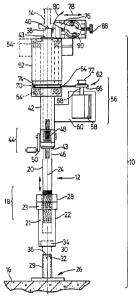Some of the information on this Web page has been provided by external sources. The Government of Canada is not responsible for the accuracy, reliability or currency of the information supplied by external sources. Users wishing to rely upon this information should consult directly with the source of the information. Content provided by external sources is not subject to official languages, privacy and accessibility requirements.
Any discrepancies in the text and image of the Claims and Abstract are due to differing posting times. Text of the Claims and Abstract are posted:
| (12) Patent: | (11) CA 2199071 |
|---|---|
| (54) English Title: | ORBITAL LATHE |
| (54) French Title: | TOUR ORBITAL |
| Status: | Expired |
| (51) International Patent Classification (IPC): |
|
|---|---|
| (72) Inventors : |
|
| (73) Owners : |
|
| (71) Applicants : |
|
| (74) Agent: | GOWLING WLG (CANADA) LLP |
| (74) Associate agent: | |
| (45) Issued: | 2001-08-07 |
| (22) Filed Date: | 1997-03-04 |
| (41) Open to Public Inspection: | 1998-09-04 |
| Examination requested: | 1997-03-04 |
| Availability of licence: | N/A |
| (25) Language of filing: | English |
| Patent Cooperation Treaty (PCT): | No |
|---|
| (30) Application Priority Data: | None |
|---|
An orbital lathe for resurfacing a fifth wheel kingpin having a
support column insertable between the kingpin and an underlying surface
generally axially aligned with the kingpin. A cutting tool is mounted for
rotation about a pin axis and has a first positioning means for moving the
cutting tool radially relative to the pin axis and a second positioning means
for rotating the cutting tool about an axis generally orthoginal to the pin axis.
Drive means are provided for rotating the cutting tool about the pin axis to
cause the cutting tool to remove material from the kingpin. A transport
mechanism acts between the support column and the positioning means to
move the positioning means and in turn the cutting tool along the pin axis.
Tour orbital permettant de surfacer le tourillon d'une cheville d'attelage dotée d'une colonne d'appui pouvant être insérée entre la cheville d'attelage et une surface sous-jacente généralement alignée dans l'axe de la cheville d'attelage. Un outil de coupe, monté de manière à pouvoir tourner autour d'une cheville d'attelage, comporte un premier dispositif de positionnement pour faire tourner l'outil de coupe radialement par rapport à la cheville d'attelage et un second dispositif de positionnement pour faire tourner l'outil de coupe sur un axe généralement orthogonal par rapport à la cheville d'attelage. Des dispositifs d'entraînement permettent de faire tourner l'outil de coupe autour de la cheville d'attelage pour enlever du matériau de cette dernière. Un mécanisme de transport, entre la colonne d'appui et le dispositif de positionnement, sert à déplacer ce dernier et, ultérieurement, l'outil de coupe le long de l'axe de la cheville d'attelage.
Note: Claims are shown in the official language in which they were submitted.
Note: Descriptions are shown in the official language in which they were submitted.

For a clearer understanding of the status of the application/patent presented on this page, the site Disclaimer , as well as the definitions for Patent , Administrative Status , Maintenance Fee and Payment History should be consulted.
| Title | Date |
|---|---|
| Forecasted Issue Date | 2001-08-07 |
| (22) Filed | 1997-03-04 |
| Examination Requested | 1997-03-04 |
| (41) Open to Public Inspection | 1998-09-04 |
| (45) Issued | 2001-08-07 |
| Expired | 2017-03-06 |
There is no abandonment history.
| Fee Type | Anniversary Year | Due Date | Amount Paid | Paid Date |
|---|---|---|---|---|
| Request for Examination | $200.00 | 1997-03-04 | ||
| Application Fee | $150.00 | 1997-03-04 | ||
| Maintenance Fee - Application - New Act | 2 | 1999-03-04 | $50.00 | 1999-03-03 |
| Maintenance Fee - Application - New Act | 3 | 2000-03-06 | $50.00 | 2000-03-03 |
| Maintenance Fee - Application - New Act | 4 | 2001-03-05 | $50.00 | 2001-03-05 |
| Final Fee | $150.00 | 2001-05-08 | ||
| Maintenance Fee - Patent - New Act | 5 | 2002-03-04 | $75.00 | 2002-03-04 |
| Back Payment of Fees | $25.00 | 2004-01-30 | ||
| Maintenance Fee - Patent - New Act | 6 | 2003-03-04 | $275.00 | 2004-01-30 |
| Maintenance Fee - Patent - New Act | 7 | 2004-03-04 | $100.00 | 2004-01-30 |
| Maintenance Fee - Patent - New Act | 8 | 2005-03-04 | $100.00 | 2005-03-03 |
| Maintenance Fee - Patent - New Act | 9 | 2006-03-06 | $100.00 | 2006-03-01 |
| Maintenance Fee - Patent - New Act | 10 | 2007-03-05 | $125.00 | 2007-02-14 |
| Maintenance Fee - Patent - New Act | 11 | 2008-03-04 | $125.00 | 2008-03-04 |
| Maintenance Fee - Patent - New Act | 12 | 2009-03-04 | $325.00 | 2009-03-16 |
| Maintenance Fee - Patent - New Act | 13 | 2010-03-04 | $125.00 | 2010-02-22 |
| Maintenance Fee - Patent - New Act | 14 | 2011-03-04 | $125.00 | 2011-02-25 |
| Maintenance Fee - Patent - New Act | 15 | 2012-03-05 | $225.00 | 2012-03-02 |
| Maintenance Fee - Patent - New Act | 16 | 2013-03-04 | $225.00 | 2013-03-01 |
| Maintenance Fee - Patent - New Act | 17 | 2014-03-04 | $225.00 | 2014-02-27 |
| Maintenance Fee - Patent - New Act | 18 | 2015-03-04 | $225.00 | 2015-02-23 |
| Maintenance Fee - Patent - New Act | 19 | 2016-03-04 | $225.00 | 2016-02-08 |
Note: Records showing the ownership history in alphabetical order.
| Current Owners on Record |
|---|
| LEFEBVRE, RICHARD |
| Past Owners on Record |
|---|
| None |